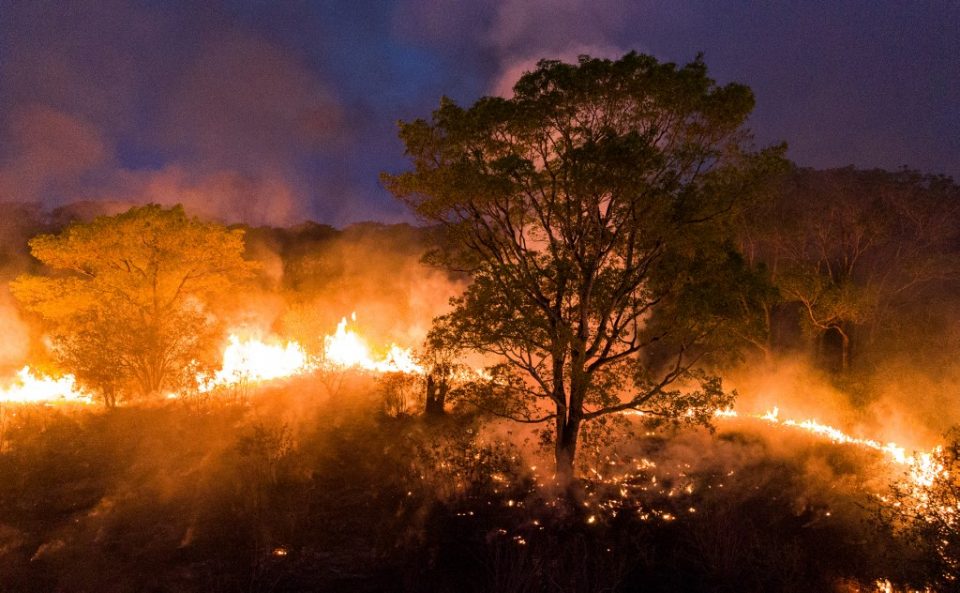
by Louis GENOT
RIO DE JANEIRO, Brazil (AFP) — The Pantanal, the world’s biggest tropical wetlands, is burning at record-shattering pace this year as drought-fueled fires devastate its vegetation and celebrated wildlife in an environmental catastrophe.
The region, which sits at the southern edge of the Amazon rainforest, is known for its immense biodiversity, drawing wildlife lovers from around the world with its jaguars, jabiru storks, giant otters, caimans, toucans, macaws and monkeys.
But in recent months, the images emerging from the region have been of charred animals’ corpses and flames stretching clear across the horizon.
“I’ve been here 20 years, and this is the worst situation I’ve ever seen,” Felipe Dias, head of the environmental group SOS Pantanal, told AFP.
Stretching from Brazil into Paraguay and Bolivia, the Pantanal is criss-crossed by rivers, swamps and marshes.
More than 2.3 million hectares (5.7 million acres) — an area 388 times the size of Manhattan — have gone up in flames in the region so far this year, according to the Federal University of Rio de Janeiro.
There have been 12,567 fires in the Brazilian Pantanal in 2020, setting a new annual record for the number of fires less than nine months into the year, according to satellite data collected by Brazil’s national space agency, INPE.
The damage is “irreparable,” and especially devastating for animals, said Juliana Camargo, head of wildlife conservation group AMPARA Animal.
“Very few animals survive. The ones that do often suffer very severe effects. They’re burned to the bone, they often have to be euthanized, or die of hunger and thirst,” she said.
“The worst part is when the people on the ground fighting the fires tell us, ‘There’s nothing we can do, everything is going to burn.’ The only hope is for it to rain, but that’s not expected until November.”
Wetlands running dry
Local volunteers have rushed to help the teams of soldiers and firefighters deployed to battle the flames.
Many of them depend on the region’s ecotourism industry, which has been battered by the twin crises of the coronavirus pandemic and the fires.
This week the flames reached a nature reserve known as the home to the world’s biggest jaguar population, Encontro das Aguas State Park.
The disaster is being driven by extreme drought.
As it happens, the world’s biggest tropical wetlands are not that wet these days.
Rainfall in the Pantanal plunged by half for the period from January to May this year, usually the height of rainy season.
Many areas that typically flood with the rains were left dry.
High temperatures and strong winds have fueled the fires.
But there are other factors in play, too.
Farmers and ranchers are increasingly introducing non-native crops to the region, which burn more easily than native vegetation, said forestry engineer Vinicius Silgueiro of the Life Center Institute (ICV).
Some clear their land using the slash-and-burn method, lighting fires that can then grow out of control.
Far-right President Jair Bolsonaro’s government has meanwhile failed to crack down on the problem, environmentalists say.
“There’s a widespread sense of impunity, a weakening of environmental protection agencies and a reduction in funding” for environmental programs, said Silgueiro.
‘New normal’?
Bolsonaro, who took office in January 2019, faces criticism for presiding over a surge in fires, not only in the Pantanal but in the Amazon.
Studies show deforestation in the Amazon is having an impact on rainfall in other regions of Brazil by shrinking the rainforest’s so-called “flying rivers”: vast clouds of mist that are carried by the wind and dump water across a large swathe of South America.
“It’s too early to know if the droughts in the Pantanal in recent years are directly linked to that,” said Silgueiro.
“But there’s no denying things are different from before. I’m from this region. I remember when it used to rain in August and September. This year, it hasn’t rained since June.”
Droughts like this year’s risk becoming the “new normal,” said Tasso Azevedo, the coordinator of Mapbiomas, a collaborative research group that tracks environmental data.
“That would be really tragic,” he said.
“Because in the Pantanal, if you have fire after fire in the same place, the vegetation can’t grow back.”
© Agence France-Presse







